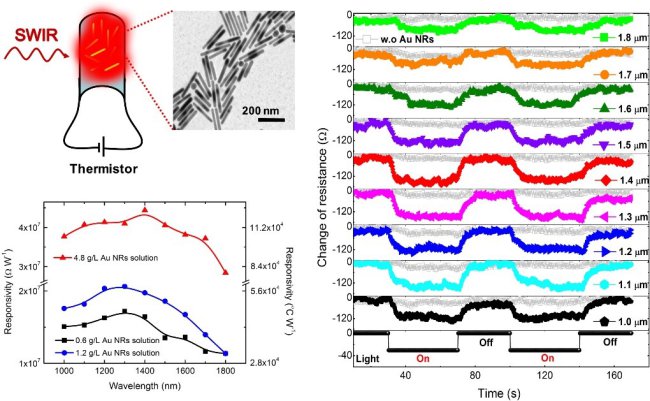
Figure caption: (Upper left) A schematic describing the hybrid Au-nanorod (NR)/thermistor device structure. (Lower left) The photoresponsivity of Au-NR/thermistor devices fabricated by different concentrations of Au NR solution. (Right) Photoresponse characteristics over time of a hybrid Au-NR/thermistor device upon exposure of monochromatic illumination (λ from 1.0-1.8 μm). Gray curves with open symbols represent the photoresponse from a control device without Au NRs.
Photodetection in the short-wave infrared (SWIR) spectrum is crucial to many applications such as thermal imaging, communications and spectroscopy. It remains a challenging task achieved often by costly low-bandgap compound semiconductors involving highly toxic elements (lead, arsenic, mercury…). In this work, we report an alternative low-cost approach for SWIR sensors which relies on the plasmonic-induced photothermal effect of solution-processed colloidal gold nanorods (Au NRs). A series of uniform solution-processed Au NRs of various aspect-ratios were prepared exhibiting a strong and well-defined longitudinal LSPR maximum from 900 nm to 1.3 µm. A hybrid device structure was fabricated by applying Au NRs on the surface of a thermistor. Under a monochromatic illumination, hybrid Au-NR/thermistor devices exhibit a clear photoresponse in the form of photo-induced resistance drop in the wavelength window from 1.0 µm to 1.8 µm. The photo-responsivity of such hybrid devices reaches a maximum value of 4.44 107 Ω/W at = 1.4 µm (intensity = 0.28 mW/cm2), a wavelength in agreement with the longitudinal LSPR of the Au NRs applied. Colloidal Au NRs, capable to perform fast conversion between photon absorption and thermal energy, thus open an interesting avenue for alternative low-cost SWIR photodetection.
Reference: Hengyang Xiang, Tingting Niu, Mathilde Schoenauer Sebag, Zhelu Hu, Xiangzhen Xu, Laurent Billot, Lionel Aigouy and Zhuoying Chen*, Small 2018, 1704013, DOI: 10.1002/smll.201704013.
Contact: ![]()
